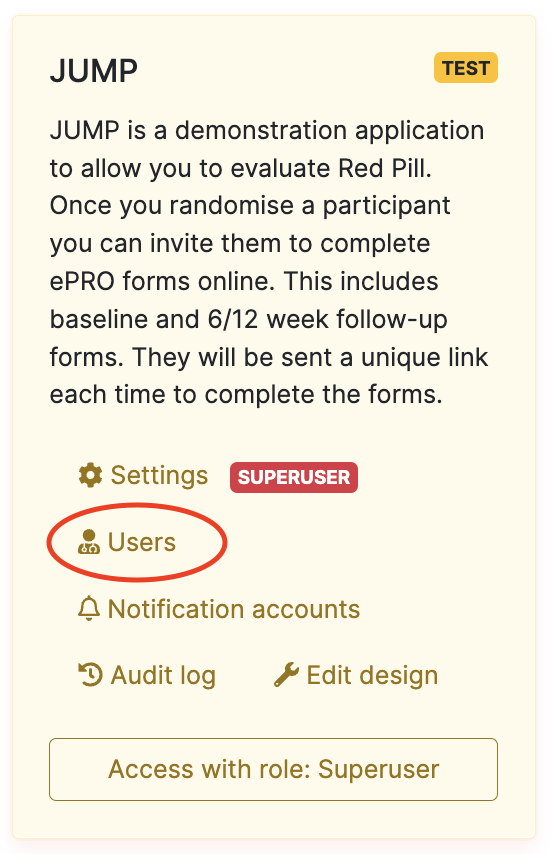Viewing user accounts and roles
In this article
Viewing accounts for a trial
Administrators can view user accounts and roles for a specific trial from the Users link in the trial panel.
 Users link in JUMP trial panel
Users link in JUMP trial panel
 Viewing user accounts for a trial
Viewing user accounts for a trial
Roles in italics are suspended. The list of user accounts and roles can be downloaded or copied using the Copy, Excel and CSV buttons. A row can be selected by clicking on it, or multiple rows can be selected using Shift-click or Ctrl-click (Cmd-click on Mac). When rows are selected, the highlighted roles can be suspended or activated using the drop-down Suspend button.
 Suspending multiple roles
Suspending multiple roles
New accounts can be created using the Create a new user button. Clicking on a name in the list shows details about that account including name, email address, date of last login and password change. The user's password can be reset using the Reset password button on this page. This sends a unique password reset link to the user's email address.
 Viewing user account detail
Viewing user account detail
The name and email address can be updated by editing the user account.
Viewing all users
Administrators can view user accounts across all trials that they administer (global users list) by clicking the Users link in the navigation bar at the top of the screen.
 Accessing global users list
Accessing global users list
 Viewing all user accounts
Viewing all user accounts
Users with an outstanding invitation to a role in a trial are shown with an INVITED badge. An INACTIVE badge is shown for accounts that have not logged in for over 6 months. These should be regularly reviewed and the roles suspended if access is no longer needed or appropriate. All roles in all trials for an account can be suspended from this list using the Suspend button.
Roles and privileges
Each trial has several roles with different privileges. The roles and privileges will vary by trial. However, the following roles are normally available:
- Superuser: Has access to all trials and all features. Reserved for Sealed Envelope staff only.
- Administrator: Has access to selected trials, but usually all features within those trials. Intended for use by trial managers and other staff at the trial co-ordinating centre.
- Investigator: Has limited access to selected trials. Investigator roles are linked to a particular trial site, and only subject data or randomisations from that site may be viewed. Investigators have no access to administrative functions (such as reports, sites, user accounts and log sections).
- Notification: Receives email notifications only - this role cannot log into the system.
Some trials may have the following roles:
- Statistician: Read-only access to participant data and ability to download for analysis.
- Monitor: Read only access to participant data and ability to create or respond to queries.
- Archivist: Download an archive containing all application data.
Randomisation systems may also have the following roles:
- Randomisation: Limited role that can only randomise and view previous randomisations for a particular site.
- Unblinding: Limited role that can only unblind treatment and view previous randomisations for a particular site.
The privileges available to each role type are fine-tuned by the configuration for a particular trial - for instance, investigators may or may not be allowed to unblind treatment. The actual privileges available are shown on the role assignment screen.
Viewing roles for a user
Clicking on a user's name shows all the user's current roles. Trials which are administered by the logged-in user are clickable and show more detail on roles. Alternatively, clicking on a user's role in the trial-specific user list shows all their roles in the trial. New roles can be added from this page and existing roles edited
 Viewing roles in a trial
Viewing roles in a trial